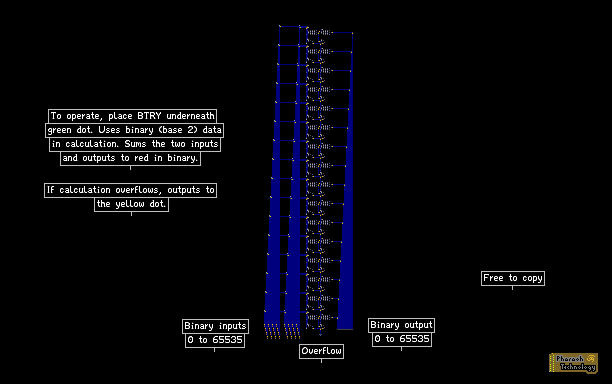16-bit Summer by Pharaoh

This is the first time I've dabbled with computer circuitry, so I hope you enjoy. This is a summation or addition calculator, and can handle 16-bit numbers.
electronic
filt
aray
circuit
adder
logic
gates
Comments
-
QuanTech 18th Aug 2016
 Summer 2016 just ended :(
Summer 2016 just ended :( -
xteric 7th May 2015
 @Pharaoh well if you would make this smaller you could make this into a core for a simplified calculator? Instead of a binary input you'll have different keys and so on.
@Pharaoh well if you would make this smaller you could make this into a core for a simplified calculator? Instead of a binary input you'll have different keys and so on. -
Qwert_Yuiop 1st May 2015
 @Pharaoh: oh, that's what i meant. And 11111111+00000001 seems to work properly.
@Pharaoh: oh, that's what i meant. And 11111111+00000001 seems to work properly. -
tomatopipps 1st May 2015
 ok next challenge: a 32-bit winter eheheheheh
ok next challenge: a 32-bit winter eheheheheh -
Pharaoh 30th Apr 2015
 11111111 + 00000001 should work, did you mean 1111111111111111 + 0000000000000001?
11111111 + 00000001 should work, did you mean 1111111111111111 + 0000000000000001? -
Qwert_Yuiop 30th Apr 2015
 @Elite01: it reads overflow, because actual result is 100000000 and output is a 8-bit number.
@Elite01: it reads overflow, because actual result is 100000000 and output is a 8-bit number. -
Elite01 30th Apr 2015
 is it broken? 11111111 + 00000001 outputs something weird...
is it broken? 11111111 + 00000001 outputs something weird... -
Pharaoh 30th Apr 2015
 @xteric, this wasn't really meant to be compact, but thank you for your suggestion. I just published this because I was proud that I finally figured out the basic concept xD
@xteric, this wasn't really meant to be compact, but thank you for your suggestion. I just published this because I was proud that I finally figured out the basic concept xD -
xteric 29th Apr 2015
 Oh and I forgot! I were able to transfer current via the inwr to the output without using filt. So maybe it's possible to do that here. check it out here: id:1776390
Oh and I forgot! I were able to transfer current via the inwr to the output without using filt. So maybe it's possible to do that here. check it out here: id:1776390 -
xteric 29th Apr 2015
 I don't know. But maybe you could make this smaller by not using so much filt. I found out when working on my microchip that ARAY based INWR scanning dosen't need filt and because of that I shrunk my chip by more than 100 pixels (as a microchip, that's pretty much)
I don't know. But maybe you could make this smaller by not using so much filt. I found out when working on my microchip that ARAY based INWR scanning dosen't need filt and because of that I shrunk my chip by more than 100 pixels (as a microchip, that's pretty much)